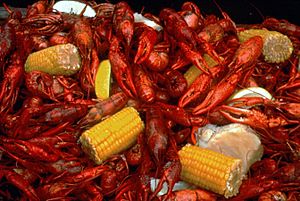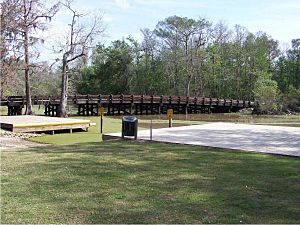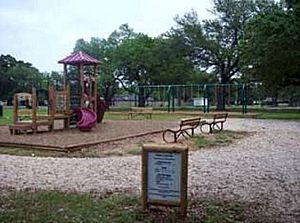Hayes, Louisiana facts for kids
Quick facts for kids
Hayes, Louisiana
|
|
|---|---|
| Country | |
| State | |
| Parish | Calcasieu |
| Founded | 1832 as Dugas Pasture |
| Named | 1904 |
| Named for | Thomas Hayes |
| Area | |
| • Total | 2.82 sq mi (7.31 km2) |
| • Land | 2.78 sq mi (7.20 km2) |
| • Water | 0.04 sq mi (0.11 km2) |
| Elevation | 10 ft (3 m) |
| Population
(2020)
|
|
| • Total | 676 |
| • Density | 243.17/sq mi (93.88/km2) |
| Time zone | UTC-6 (CST) |
| • Summer (DST) | UTC-5 (CST) |
| ZIP Codes |
70646
|
| Area Code | 337 |
| FIPS code | 22-33490 |
Hayes (pronounced heɪz) is a small community in Calcasieu Parish, Louisiana, United States. It's a place where the government counts the population, called a census-designated place. In 2010, about 780 people lived there. Hayes is part of the larger Lake Charles area.
Hayes is also known as the home of Rosco, a musical artist from the Pop duo Jaime & Rosco.
Contents
Geography and Location
Hayes is in the southeastern part of Calcasieu Parish. It sits on the west side of Bayou Lacassine, a waterway that forms the border with Jefferson Davis Parish.
Louisiana Highway 14 goes right through the middle of Hayes. This road connects Hayes to nearby towns like Bell City (3 miles west) and Lake Arthur (18 miles southeast). Lake Charles, the main city in Calcasieu Parish, is about 26 miles northwest.
The community covers about 2.8 square miles (7.3 square kilometers). Most of this area is land, with a small part (about 0.04 square miles or 0.1 square kilometers) being water.
History of Hayes
Early Settlement and Naming
Long ago, Hayes was known as Dugas Pasture. It was named after a cattle rancher who found this rich grazing land. The area was naturally protected by a bayou, swamps, and marshes, making it a safe place for cattle.
In 1832, Thomas Hayes became the first white settler in the area. He and his wife, Mary Ann Foreman, made their home near the Lacassine Bayou. Later, the community was named "Hayes" after him in 1904.
Growth and Development
William Holland, who was born in Tennessee in 1809, was another important early settler. He had nine children and started the first school in Hayes. He moved an old slave cabin to his land and hired his friend Tom Cannon as the teacher.
In 1854, Mrs. Bazeline Derouen bought land in the area. The first Methodist church was built on her property in 1898. Before this, traveling Methodist preachers visited homes in Hayes as early as 1835. When the railroad came to Hayes in 1905, the church building was moved to a more central location.
The Lorrain family, from France, settled in Hayes around 1860. Their settlement had mills for bricks, sugar, grits, and lumber. They also built a school and hired a teacher from France. Later, this school also moved to Hayes. Around 1880, the Lorrain settlement even had a post office.
Other families like the Primeaux, Gibbs, Brown, and Atkinson families also moved to Hayes. The Gibbs family opened a general store with living quarters upstairs.
For many years, Hayes was quite isolated. Midwives helped deliver most babies. A Cherokee "medicine woman" used plants to treat illnesses. The first doctor didn't arrive until 1916.
The Railroad Arrives
The Louisiana Western Railroad was completed in 1904. It connected Hayes to other towns like Lake Charles and Lake Arthur. This railroad made Hayes a busy community overnight. Toliver Hayes, the son of the first settler, sold land for the railroad and a depot. This officially made "Hayes" the permanent name for the area.
After the railroad, a saw mill and a rice mill were built. A post office also opened. Felix Hebert became postmaster in 1911, and Jesse Leo Thom served for 20 years.
Important Events in the 20th Century
- 1903: Land was given for the First Baptist Church of Hayes.
- 1906: Hayes became a "dry town," meaning alcohol sales were not allowed.
- 1910: The first public school, overseen by the Calcasieu School Board, opened.
- 1923: Work began on a major highway project called the "Lafitte Cut-Off Old Spanish Trail."
- 1930: The Magnolia Theater in Hayes installed new "talking picture" equipment. Even though Hayes was small, it had modern entertainment!
- 1934: Oil was discovered in the area.
- 1938: Electricity came to Hayes.
- 1941: Hayes Elementary school had 140 students.
- 1944: The Hayes Library opened in Martin's Store.
- 1946: A natural gas plant was built.
- 1947: The first PTA (Parent-Teacher Association) was formed.
- 1953: St. Daniel Catholic Chapel was dedicated.
- 1955: The Hayes Branch of the Calcasieu Parish library moved into a new building.
- 1968: The Hayes Water System was created.
- 1971: Hayes Elementary and Bell City Schools joined together.
Climate and Weather
People in Hayes always need to be ready for hurricane season, which runs from June 1 to November 30. During this time, there's a chance they might need to leave their homes for safety.
- The warmest month is usually July, with temperatures around 91°F (33°C). The hottest ever recorded was 105°F (41°C) in 2000.
- The coolest month is January, with temperatures around 41°F (5°C). The coldest ever recorded was 11°F (-12°C) in 1951.
- May usually gets the most rain, about 6.06 inches (15.4 cm). February gets the least, about 3.27 inches (8.3 cm).
Demographics
| Historical population | |||
|---|---|---|---|
| Census | Pop. | %± | |
| 2020 | 676 | — | |
| U.S. Decennial Census | |||
In 2010, the population of Hayes was 780 people. By 2020, it was 676.
Culture
Hayes has a strong Cajun culture. Many people speak a special version of the Cajun-French language. The area also has unique traditions and delicious food.
The Cajun cuisine from this region is very famous in the United States. One popular dish is boiled crawfish.
Outdoor Recreation
Hayes offers several places for outdoor fun and activities.
Lorrain Park
Lorrain Park is located by the Lorrain Bridge. This bridge is special because of its design and is listed in the National Register of Historical Places. It was first built as a wooden drawbridge around 1895. After being damaged and repaired over the years, it was rebuilt and reopened in 2004.
Lorrain Park has a public boat launch for getting into the Lacassine Bayou. There are also two wharves and a fish cleaning area. If you like camping, the park has spots for tents and RVs with electricity.
Hayes Park
Hayes Park is a great place for families. It has swing sets, picnic tables, a walking trail, and playground equipment for younger kids. You can find it behind the Calcasieu Parish Library-Hayes Branch.
Students from Bell City FFA helped build this park in 2010 with a special grant.
Hunting and Fishing
Hunting is very popular in Hayes, especially for ducks and geese. You can find good hunting spots in Bayou Lacassine and nearby rice fields. Many guides offer hunting trips for visitors.
The Lacassine National Wildlife Refuge is a large wildlife area nearby. Its main feature, Lacassine Pool, is a 16,000-acre (6,475-hectare) freshwater area. It's about 4.5 miles south of Highway 14.
Hunting and fishing are favorite activities at the refuge. You can also enjoy a nature drive, walking trails, and observation towers. It's a great place for bird watching, too, as many types of birds live there. You might also see alligators, mink, otter, and raccoons.
Fishing Tournaments
Hayes hosts fishing tournaments like the ABT Tournament and Up and Coming Outdoors. Fishermen compete to catch bass in public waters around Hayes. These tournaments often focus on "catch and release" to protect the fish.
Lorrain Bridge Queens and Kings Pageant
Every June, Hayes holds the Lorrain Bridge King and Queen's Pageant. This fun event has been happening for many years.
Education
Students from Hayes attend Bell City High School for grades K-12. This school is located in Bell City, about 3 miles west of Hayes.
Musicians from Hayes
Hayes has been home to talented musicians who have made a mark in Cajun music.
- Wallace DeRouen (1929-1988) was a Cajun guitarist born in Hayes. He played with famous musicians like Phil Menard and Joe Bonsall. He also hosted a radio show for many years. In 1990, he was added to the Cajun French Music Association's Hall of Fame.
- Rufus Thibodeaux (1934-2005) started playing guitar at age six and fiddle at twelve. He played with Jimmy Newman and recorded the first Cajun French song to become a gold record, "Lache Pas la Patate." Rufus wrote many songs and received numerous awards, including being inducted into the Louisiana Hall of Fame.
Restaurants
- Poole's Boil N Go, 7710 Crochet Road. This restaurant serves delicious boiled crawfish when they are in season.
Churches
- First Baptist Church, 7718 E Highway 14
- Faith Christian Fellowship, 7769 Georgia Avenue
Cemeteries
- Hayes Cemetery; The oldest known grave is Thomas Hayes, 1809-1870.
- Derouen Cemetery; The oldest known grave is Natalie Derouen, 1824-1868.
See also
 In Spanish: Hayes (Luisiana) para niños
In Spanish: Hayes (Luisiana) para niños





